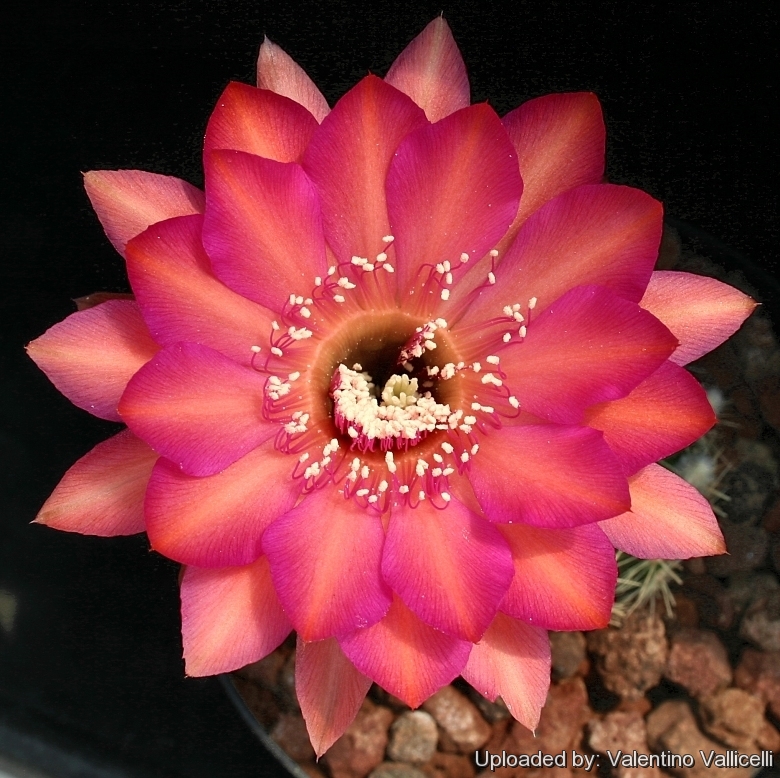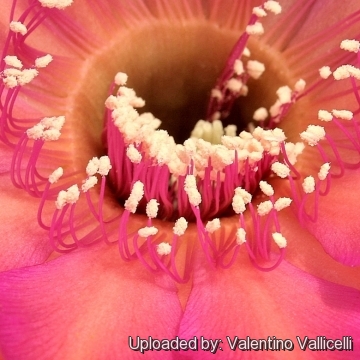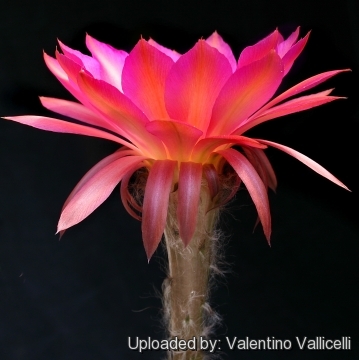




Your support is critical to our success.

A Schick Hybrid. ISI 98-5; HBG 81757, Schick 896-16.
Origin and Habitat: Garden origin (A distictive cultivar created by cacti enthusiast and hybridiser Bob Schick )
Synonyms:
Description: This plant is one of the most popular and appreciated Echinopsis cultivars, it is the result of more than 20 years of devoted work by cacti enthusiast and hybridiser Bob Schick.
Flowers: Two-toned up to 11/12 cm across.
Tepals: Bright purple/red whit a light orange midrib.
Throat-circle: Subtle orangish.
Filaments: Vivid fuchsia.
Anthers: Creamy coloured.
Subspecies, varieties, forms and cultivars of plants belonging to the Echinopsis hybrid (Schick Hybrids) group
 Echinopsis cv. Anastasia: has delicate bicoloured white with lilac-pink flowers, with a brighter pink midrib on outer petals.
Echinopsis cv. Anastasia: has delicate bicoloured white with lilac-pink flowers, with a brighter pink midrib on outer petals. Echinopsis cv. Beautiful Dreamer: has apricot or salmon pink flowers outer tepals pinkish with a purple-violet mid-line.
Echinopsis cv. Beautiful Dreamer: has apricot or salmon pink flowers outer tepals pinkish with a purple-violet mid-line. Echinopsis cv. Candlelight: has small to medium sized bicolored blooms (up to 9 cm across) sand yellow and pure yellow.
Echinopsis cv. Candlelight: has small to medium sized bicolored blooms (up to 9 cm across) sand yellow and pure yellow. Echinopsis cv. Cassandra: has two-toned blooms up to 11/12 cm across. Bright purple/red whit a light orange midrib.
Echinopsis cv. Cassandra: has two-toned blooms up to 11/12 cm across. Bright purple/red whit a light orange midrib. Echinopsis cv. Coquette: has bright yellow, fragrant blooms, up to 11(-12) cm across, but usually less than 10 cm.
Echinopsis cv. Coquette: has bright yellow, fragrant blooms, up to 11(-12) cm across, but usually less than 10 cm. Echinopsis cv. Crepe Crusader: light magenta with cream-colored to light orange basal stripe and dark pinkish-red midrib.
Echinopsis cv. Crepe Crusader: light magenta with cream-colored to light orange basal stripe and dark pinkish-red midrib. Echinopsis cv. Daydream: has bicolored blooms, Up to 11.5 cm across, tannish-orange and pink with darker pink midrib.
Echinopsis cv. Daydream: has bicolored blooms, Up to 11.5 cm across, tannish-orange and pink with darker pink midrib. Echinopsis cv. Don Juan: has bicoloured blooms, deep purple with a deep red base and midrib, outer tepals largely red.
Echinopsis cv. Don Juan: has bicoloured blooms, deep purple with a deep red base and midrib, outer tepals largely red. Echinopsis cv. Eclipse: flowers up to 11 cm across, pinkish-red with a lighter midrib. Outer tepals yellow and project beyond the darker inners.
Echinopsis cv. Eclipse: flowers up to 11 cm across, pinkish-red with a lighter midrib. Outer tepals yellow and project beyond the darker inners. Echinopsis cv. Eddie: has delicate pink blooms with fine pink outer margin, light pinkish-red basal stripe and salmon-pink darker midrib.
Echinopsis cv. Eddie: has delicate pink blooms with fine pink outer margin, light pinkish-red basal stripe and salmon-pink darker midrib. Echinopsis cv. Edwardian Lady: has bicolored purplish-pink and white flowers with narrow bright yellow basal stripe. Up to 12 cm across.
Echinopsis cv. Edwardian Lady: has bicolored purplish-pink and white flowers with narrow bright yellow basal stripe. Up to 12 cm across. Echinopsis cv. Elegant Lady: Flowers white, with outer tepals projecting beyond inners, bicolored white and light pinkish-purple.
Echinopsis cv. Elegant Lady: Flowers white, with outer tepals projecting beyond inners, bicolored white and light pinkish-purple. Echinopsis cv. Eroica: Flowers up to 10,5 cm cm across, rich pink with darker midrib and paler margin.
Echinopsis cv. Eroica: Flowers up to 10,5 cm cm across, rich pink with darker midrib and paler margin. Echinopsis cv. Galaxy: flowers white with prominent purplish-pink basal stripe and midrib.
Echinopsis cv. Galaxy: flowers white with prominent purplish-pink basal stripe and midrib. Echinopsis cv. Gossamer: flowers light lavender-pink with darker midrib and a small rounded white area at base.
Echinopsis cv. Gossamer: flowers light lavender-pink with darker midrib and a small rounded white area at base. Echinopsis cv. Hot Lips: flowers dark scarlet about 10-11cm across.
Echinopsis cv. Hot Lips: flowers dark scarlet about 10-11cm across. Echinopsis cv. Icarus: flowers pale pastel yellow with bright yellow midrib.
Echinopsis cv. Icarus: flowers pale pastel yellow with bright yellow midrib. Echinopsis cv. Intrigue: Flowers dark red tinted purple with an orange midrib. Outer tepals pale tawny-colored.
Echinopsis cv. Intrigue: Flowers dark red tinted purple with an orange midrib. Outer tepals pale tawny-colored. Echinopsis cv. Jealousy: flowers bright to pastel yellow. Sepaloids pinkish-purple longer than tepals.
Echinopsis cv. Jealousy: flowers bright to pastel yellow. Sepaloids pinkish-purple longer than tepals. Echinopsis cv. Lochinvar: flowers lavender-pink with darker midrib.
Echinopsis cv. Lochinvar: flowers lavender-pink with darker midrib. Echinopsis cv. Madame Pele: flowers bicoloured flowers up to 10/12 cm across, dark vermilion with bright paler magenta margin.
Echinopsis cv. Madame Pele: flowers bicoloured flowers up to 10/12 cm across, dark vermilion with bright paler magenta margin.- Echinopsis cv. Maria Piazza: has large sized flowers up to 15 cm across, rich purplish-pink with dark pinkish-red midrib.
 Echinopsis cv. Maria Piazza f. cristasta: Crested form.
Echinopsis cv. Maria Piazza f. cristasta: Crested form. Echinopsis cv. Monet: flowers bicolored pastel magenta to dusky purplish-red and bronzy-orange. Outer tepals paler than inners.
Echinopsis cv. Monet: flowers bicolored pastel magenta to dusky purplish-red and bronzy-orange. Outer tepals paler than inners. Echinopsis cv. Princess Anne: flowers pale pink with a white base the midrib may be slightly deeper pink.
Echinopsis cv. Princess Anne: flowers pale pink with a white base the midrib may be slightly deeper pink. Echinopsis cv. Romance: flowers dark velvety pink with narrow pale purplish-pink margins and dark reddish-pink midrib.
Echinopsis cv. Romance: flowers dark velvety pink with narrow pale purplish-pink margins and dark reddish-pink midrib. Echinopsis cv. Samantha Smith: blooms are about 12 cm in diameter, ruffled, yellowish-orange.
Echinopsis cv. Samantha Smith: blooms are about 12 cm in diameter, ruffled, yellowish-orange. Echinopsis cv. Sierra Skyline: Up to 14 cm across prominently fringed apricot to salmon. Outers mainly light purplish-pink.
Echinopsis cv. Sierra Skyline: Up to 14 cm across prominently fringed apricot to salmon. Outers mainly light purplish-pink. Echinopsis cv. Sorceress: flowers bicolored mainly deep magenta with thin, dark bronzy-orange or deep red basal stripe and midrib.
Echinopsis cv. Sorceress: flowers bicolored mainly deep magenta with thin, dark bronzy-orange or deep red basal stripe and midrib. Echinopsis cv. Spring Blush: flowers beige-pink with white to yellow basal stripe and pink midrib.
Echinopsis cv. Spring Blush: flowers beige-pink with white to yellow basal stripe and pink midrib. Echinopsis cv. Spring Symphony: flowers light purplish-pink with darker midrib, a white margin and yellow to ivory-coloured basal stripe.
Echinopsis cv. Spring Symphony: flowers light purplish-pink with darker midrib, a white margin and yellow to ivory-coloured basal stripe. Echinopsis cv. Syncopation: petals subequal, dark pinkish-purple, with darker reddish midrib.
Echinopsis cv. Syncopation: petals subequal, dark pinkish-purple, with darker reddish midrib. Echinopsis cv. Temptress: blooms are about 11 cm across, dark satiny fuchsia with deep red at base.
Echinopsis cv. Temptress: blooms are about 11 cm across, dark satiny fuchsia with deep red at base. Echinopsis cv. Träumerei: blooms large, up to 13 cm in diameter pastel orange suffused with magenta, midrib light yellow/amber.
Echinopsis cv. Träumerei: blooms large, up to 13 cm in diameter pastel orange suffused with magenta, midrib light yellow/amber. Echinopsis cv. Windigo: Bicolored magenta and bronzy orange to bright red with paler midrib.
Echinopsis cv. Windigo: Bicolored magenta and bronzy orange to bright red with paler midrib.
Bibliography: Major references and further lectures
1) John N. Trager "Huntington Botanical Gardens" online: http://www.huntington.org/BotanicalDiv/Schick/hybrids/cassandra.html retrieved on 03-11-2013

Echinopsis cv. Cassandra Photo by: Valentino Vallicelli

Echinopsis cv. Cassandra Photo by: Valentino Vallicelli
Cultivation and Propagation: These plants are summer growers species that offer no cultivation difficulties. Grow them in rich, airy, porous, growing medium which mainly consists of non organic material such us clay, pumice, lava grit, and only a little peat or leaf-mould. If potted, repot preferably in the spring, if their roots become cramped. Generally, they should be repotted every other year in order to provide fresh soil. However, this doesn't necessarily mean they'll need larger containers. Fill about a quarter of the pot with broken crocks, gravel, etc. to promote good drainage. After repotting, do not water for a week or more. Water regularly in summer (but do not overwater), and let their soil dry out between waterings, keep rather dry in winter. No water should ever be allowed to stand around the roots. Feed with a high potassium fertilizer in summer.
Exposure: Outside they need a bright exposure, full sun or half shade in summer if the location is exceedingly hot or bright, inside needs bright light, and some direct sun. It can tolerate moderate shade, and a plant that has been growing in shade should be slowly hardened off before placing it in full sun as the plant will be severely scorched if moved too suddenly from shade into sun.
Frost Tolerance: Light frost protection required for safe cultivation, but many of the hybrids very frost resistant if kept dry (The hardiness varies from -5°C to -12° C depending on clone). This plants need a period of cool rest in winter to produce flowers abundantly. They flower freely indoors if conditions suit them.
Pest & Disease:** Watch for infestations of mealybug, scale insects and spider mite.
Propagation:*** Easy to propagate from cuttings. Most of the Echinopsis clones produce shoots and can be reproduced exclusively by cuttings. The cuttings will take root in a minimum temperature of 20° C. Cuttings of healthy shoots can be taken in the spring and summer, Cut them with a sharp, sterile knife, leave the cutting in a warm, dry place for a week or weeks (depending on how thick the cutting is) until a callus forms over the wound. Once the callus forms, the cutting may be inserted in a container filled with firmed cactus potting mix topped with a surface layer of coarse grit. They should be placed in the coarse grit only; this prevents the cut end from becoming too wet and allows the roots to penetrate the rich compost underneath. The cuttings should root in 2 to 6 weeks.
Notes: How to Grow new hybrid from seeds: The reproduction by seed is also possible but the offspring will not be identical to the mother plant. The Echinopsis will produce several fruit with hundreds of seeds each season. After the flower dies off and the pods are ripen it is possible to collect them from under the dried flower. Then place the seeds in some water to soak overnight. Fill germination trays with a well blended mixture of 60% peat moss 40% vermiculite and one to one part of coarse sand or pumice. Use a horse syringe to suck the small seeds and some of the water into the syringe. With the syringe, distribute the seeds evenly in the germination tray, shaking the syringe so the seeds don't settle at the bottom and all come out at once. Place then the trays in filtered sun, cover with a glass sheet and keep the soil moist until the seeds germinate in approximately 2 to 6 weeks. They will look like small green spheres, somehow red in bright light. Then gradually remove the glass cover. When the small cacti start to sprout tiny spines, use a pair of tweezers to transfer them from the propagation trays into 5 cm pots filled with the same soil mix used in the germination trays. Allow the small cacti to grow for about one/two year and then move the cacti to 10 cm pots and allow them to grow further.
| Your Actions | |
|---|---|
| Back to Echinopsis index | |
| Back to Cactaceae index | |
 |
Back to Cacti Encyclopedia index |
Privacy stantement - Terms and conditions - How to cite - About us - Feedback - Donate




